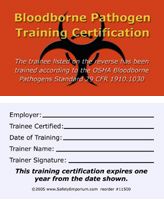| The Home page of ILPI's Safety Data Sheet (SDS) Resource, the leader in SDS information since 1995! | |
| The history and philosophy behind this resource. | |
| A curated collection of books and reference materials concerning Safety Data Sheets and closely related topics. | |
| Paste your plain text SDS into the SDS-Demystifier, and it will be converted into a hypertext-enriched document with links to detailed explanations of each key term. | |
| An extensive list of frequently asked questions about Safety Data Sheets including regulations, content, compliance, and more. | |
| A humorous take on Safety Data Sheet jargon. Fill in the blanks on our entry form to generate a personalized Unsafety Data Sheet to share with your coworkers. | |
| Since 1995, we've maintained this massive curated list of the best places to find Safety Data Sheets on the Internet. | |
| You are here! Way more than a glossary, this hypertext-enhanced resource covers hundreds of SDS-related terms and expert knowledge. Each entry includes both the SDS relevance and links to additional authoritative resources. | |
| Archived results of Safety Data Sheet related polls taken by some of our millions of site visitors | |
| The OSHA regulations behind SDS regulations, including the inspection guidelines and over 400 official interpretations letters under the Hazard Communication Standard | |
| Commercial suppliers of SDS authoring and management software as well as cloud compliance services. | |
| Commercial companies that will create SDS's for your specific needs as well as SDS translation companies. |

Safety signs, banners, and scoreboards? Get yours at Safety Emporium!
Definition

Get your bloodborne pathogen safety materials from Safety Emporium.
A nephrotoxin is a toxic agent or substance that inhibits, damages or destroys the cells and/or tissues of the kidneys. This is an example of a cytotoxin. The adjective form is nephrotoxic.
Inflammation of the kidneys is called nephritis. Study of the kidneys is called nephrology. Something that pertains to the kidneys is called nephritic or renal. Disease of the kidneys is called nephropathy or renal disease.
Additional Info
Your kidneys are vital organs responsible for regulating the water content of your body, maintaining proper pH and for the excretion of bodily wastes as urine.
Besides causing direct damage to your kidneys, nephrotoxins can worsen or aggravate other conditions such as diabetes, hypertension (high blood pressure), and cardiovascular (heart) disease. They can also interfere with vitamin D metabolism and hormone synthesis.
Signs or symptoms of exposure to nephrotoxins may include proteinuria (protein in the urine), edema, kidney stones, and uremia (excess an excess of urea in the blood, characterized by headache, nausea and/or coma).
While a wide variety of chemicals cam cause kidney toxicity, there is no authoritative comprehensive list of such chemicals.
SDS Relevance
Always check Section 11 (toxicological information) of the Safety Data Sheet before you work with a new material for the first time. Both acute and chronic (long and short-term) exposure to certain organic chemicals can cause inflammation, injury or severe damage to the kidneys.
Treat nephrotoxins with great respect, particularly "heavy metals" such as lead, cadmium and mercury as well as chlorocarbons such as carbon tetrachloride and chloroform. If you must use such materials, Section 8 (exposure controls/personal protection) for the proper controls to minimize the number of exposed workers (such as fume hoods) as well as respirators, gloves etc. to protect individual workers. Make sure that all containers are properly labeled as well.

Get your GHS-compliant labels and signs from Safety Emporium.
A 2013 study in the International Journal of Renovascular Disease (see link under Further Reading) concluded that workers in certain occupations are at an increased risk for chronic kidney disease. The rates of various occupations compared to the control group were:
- 4.3 times higher for Building, Grounds Cleaning and Maintenance
- 4.4 times higher in Healthcare Practitioners and Technical
- 4.7 times higher in Transportation and Material Moving
- 4.7 times higher in Computer and Mathematical
- 4.8 times higher in Production
- 5.3 times higher in Food Preparation and Serving Related
- 6.1 times higher in Healthcare Support and in Legal.
Finally note that exposure to multiple nephrotoxins at moderate levels may have a greater than expected nephrotoxicity. For example, see Liu, J, et al. "Chronic combined exposure to cadmium and arsenic exacerbates nephrotoxicity, particularly in metallothionein-I/II null mice" Toxicology 2000, 147, 157-166. In addition, high stress behaviors/occupations as well as lower socioeconomic status have been linked to kidney disease.
Further Reading

Kidney health depends on staying properly hydrated. Get this and related heat stress prevention signs from Safety Emporium.
- Acute toxic kidney injury from Ren. Fail., 2019, 41(1), pp 576-594.
- Nephrotoxicity and Renal Pathophysiology: A Contemporary Perspective from Tox. Sci., 2018, 164(2), pp 379-390.
- OSHA's preamble to the Cadmium Standard discusses the nephrotoxic effects of cadmium in great detail. This seems to be missing, but an archived copy is available through the Internet Wayback Machine.
- OSHA Safety Sheet on Cadmium, including details on health effects with good discussion of the renal effects.
- An OSHA Brief on Medical Evaluation of Renal Effects of Cadmium Exposures, to help physicians understand the medical surveillance provisions of the Cadmium standard.
- Heavy Metal Nephropathy at the Merck Manual Professional version.
- Occupational risk and chronic kidney disease: a population-based study in the United States adult population from Int J Nephrol Renovasc Dis 2013, 6, pp 53-59.
- Occupational Renal Diseases.
- Nephrotoxicity (Renal Toxicity), a common side effect of chemotherapy, at Chemocare.com
See also: cytotoxin, hypertension, poison, systemic, toxic.